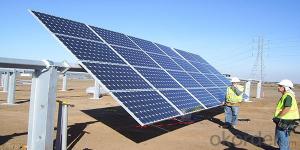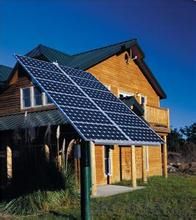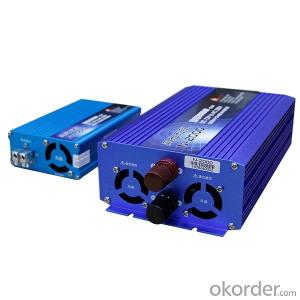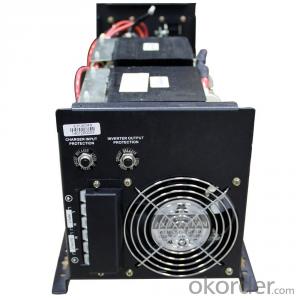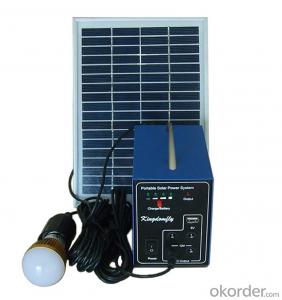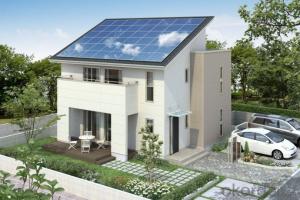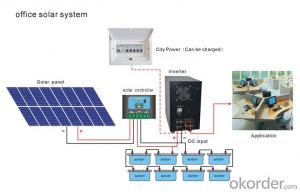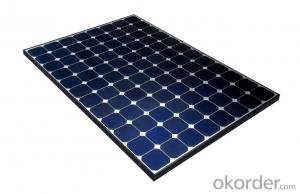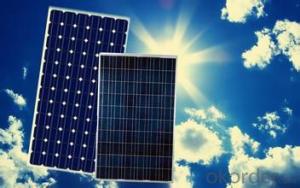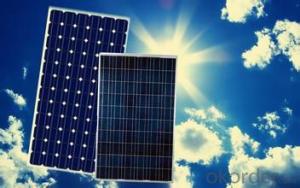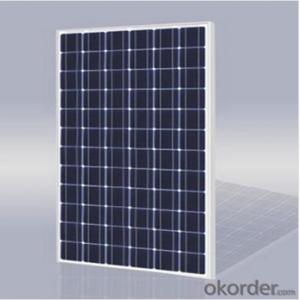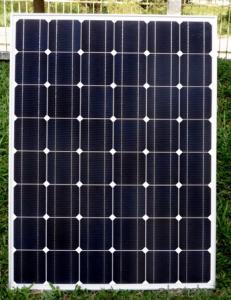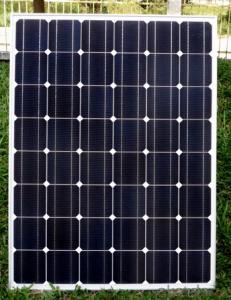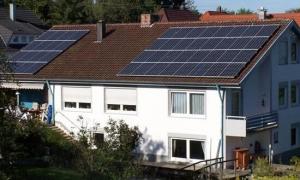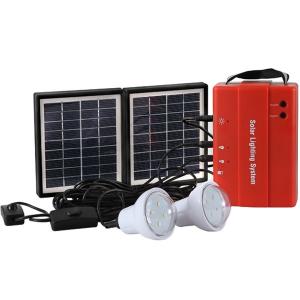116kw CNBM Monocrystalline Silicon Solar Energy Systems Home Panel
- Loading Port:
- Tianjin
- Payment Terms:
- TT OR LC
- Min Order Qty:
- 60 watt
- Supply Capability:
- 1000 watt/month
OKorder Service Pledge
OKorder Financial Service
You Might Also Like
Specification
116KW CNBM Monocrystalline Silicon Panel for Home Using
Production description
Garden Television (HGTV) network. Actress Daryl Hannahpromotes off-grid living and constructed her home in Colorado according to those principles, as does survival expert and Dual Survival co-star Cody Lundin,[3]who lives in a self-designed, passive solar earth house in the high-desert wilderness of Northern Arizona, collecting rainwater, composting waste, and paying nothing for utilities.[4][5]
The large magnitude of solar energy available makes it a highly appealing source of electricity. The United Nations Development Programme in its 2000 World Energy Assessment found that the annual potential of solar energy was 1,575–49,387 exajoules (EJ). This is several times larger than the total world energy consumption, which was 559.8 EJ in 2012.
wind, micro hydro, geothermal; with agenerator or Micro combined heat and power with adequate fuel reserves. Such a system is called a stand-alone power system. In addition, it is possible to simply eliminate electric power such as in Old Order Amish and Old Order Mennonite communities.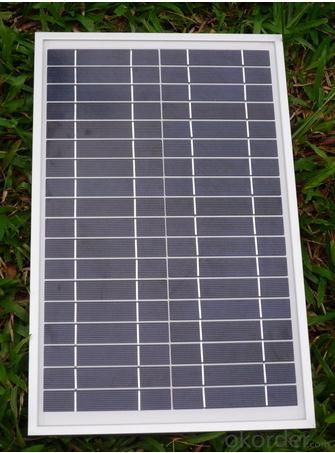
Feature
1.High conversion efficiencies resulting in superior power output performance.
2.Outstanding power output even in low light or high temperature conditions
3.Optimized design for ease of soldering and lamination
Physical characteristic
1. Rigorous quality control meets the highest international standards.
2. High-transmissivity low-iron tempered glass, strong aluminium frame.
3. Using UV-resistant silicon.
4. IS09001/14001/CE/TUV/UL
Packaging
26pcs in one carton 6pallets in 20foot container 14pallets in 40 foot container.
- Q: Can solar energy systems be used for powering financial institutions or banks?
- Certainly, financial institutions and banks can utilize solar energy systems to power their operations. In fact, many of these institutions have already embraced solar energy as a means to meet their energy requirements. Solar energy systems offer a dependable and environmentally friendly source of electricity, diminishing their reliance on conventional fossil fuels and lessening their carbon footprint. Typically, financial institutions and banks possess large buildings with substantial energy consumption due to the numerous electronic devices, lighting, and HVAC systems necessary for their functioning. By installing solar panels on rooftops or nearby areas, these institutions can generate a substantial amount of electricity to satisfy their energy demands. Furthermore, solar energy systems can aid financial institutions and banks in reducing their long-term energy expenses. While the initial investment may be higher compared to conventional energy sources, the savings accrued from decreased electricity bills over time can offset the initial costs. Consequently, this can result in significant financial advantages for these institutions, contributing to their overall sustainability and profitability. Additionally, the utilization of solar energy can enhance the reputation of financial institutions and banks by demonstrating their commitment to environmental sustainability and renewable energy. This can attract environmentally conscious customers and investors who value businesses that prioritize eco-friendly practices. Moreover, solar energy systems can furnish a reliable power supply to financial institutions and banks, ensuring uninterrupted operations even during power outages or grid failures. This is especially critical for institutions that handle sensitive financial transactions and necessitate a continuous power supply to maintain data security and operational stability. In summary, solar energy systems can effectively power financial institutions and banks, providing a sustainable and cost-effective solution to meet their energy needs. By embracing solar energy, these institutions can mitigate their environmental impact, reduce energy costs, enhance their reputation, and guarantee reliable operations.
- Q: How do solar energy systems impact the overall energy independence of a building?
- Solar energy systems can have a significant impact on the overall energy independence of a building. By harnessing the power of the sun, these systems generate clean and renewable energy, reducing the dependency on traditional fossil fuel sources. This shift towards solar energy allows buildings to become more self-sufficient and less reliant on the grid for their energy needs. One key aspect of solar energy systems is their ability to generate electricity. By installing solar panels on rooftops or in open spaces, buildings can produce their own electricity, reducing the need to purchase it from external sources. This not only lowers energy costs but also provides a reliable source of power that is not subject to price fluctuations or supply disruptions. With a properly sized solar system, a building can potentially meet all or a significant portion of its electricity demand. Moreover, solar energy systems often come with storage options such as batteries, allowing excess electricity generated during the day to be stored for use at night or during cloudy periods. This feature enhances the resilience of the building's energy supply and further reduces reliance on the grid. In addition to electricity, solar energy systems can also contribute to the heating and cooling needs of a building. Solar thermal systems use the sun's energy to heat water or air, which can then be used for various purposes such as space heating, hot water supply, or even air conditioning. By utilizing solar thermal technology, buildings can reduce their reliance on traditional heating and cooling systems powered by fossil fuels or electricity. Furthermore, solar energy systems have a positive environmental impact. By replacing conventional energy sources with clean and renewable solar energy, buildings can significantly reduce their carbon footprint and contribute to mitigating climate change. This shift towards clean energy also helps in reducing air and water pollution associated with traditional energy generation methods. Overall, solar energy systems play a crucial role in enhancing the energy independence of a building. By generating electricity and providing heating and cooling options through clean and renewable solar energy, buildings can reduce their reliance on external energy sources, decrease costs, enhance resilience, and contribute to a more sustainable future.
- Q: Can solar energy systems be integrated with battery storage?
- Yes, solar energy systems can be integrated with battery storage. Battery storage allows excess solar energy generated during the day to be stored for use during times when the sun is not shining, such as at night or during cloudy weather. This integration enhances the reliability and efficiency of solar energy systems by providing a continuous and reliable source of electricity.
- Q: How does the performance of solar panels vary based on the altitude?
- The performance of solar panels can vary based on altitude due to several factors. One of the main factors is the amount of sunlight that reaches the panels. As altitude increases, the atmosphere becomes thinner, allowing for more direct sunlight to reach the panels. This can result in increased efficiency and power output of the solar panels. Additionally, the temperature at higher altitudes tends to be lower, which can also positively impact the performance of solar panels. Solar panels operate more efficiently at lower temperatures, as excessive heat can cause a decrease in their efficiency. Therefore, the cooler temperatures at higher altitudes can help to maintain the panels' optimal operating temperature, leading to improved performance. On the other hand, altitude can also have some negative effects on solar panel performance. At higher altitudes, there may be an increase in snowfall or ice formation, which can obstruct the sunlight and reduce the efficiency of the panels. Additionally, extreme weather conditions such as high winds or hailstorms that are more prevalent at higher altitudes can potentially damage the panels, affecting their performance. It is important to note that the overall impact of altitude on solar panel performance may vary depending on specific geographical locations and local climate conditions. Therefore, it is recommended to consider these factors and consult with experts or conduct thorough research when installing solar panels at different altitudes to maximize their performance.
- Q: Are there any limitations to installing a solar energy system in a homeowner's association?
- Yes, there can be limitations to installing a solar energy system in a homeowner's association (HOA). Some HOAs may have specific rules and regulations regarding the installation of solar panels, such as restrictions on the size, location, or appearance of the panels. Additionally, the HOA may require approval or permits before installing a solar energy system. It is important for homeowners to review the HOA's guidelines and consult with the association before proceeding with the installation.
- Q: Are there any insurance requirements for installing a solar energy system?
- Yes, there are typically insurance requirements for installing a solar energy system. Homeowners or businesses installing a solar energy system are often required to have adequate insurance coverage to protect against potential damages or liabilities associated with the installation and operation of the system. This may include general liability insurance, property insurance, and potentially additional coverage specific to solar energy installations. It is important to consult with your insurance provider and review local regulations to determine the specific insurance requirements for installing a solar energy system in your area.
- Q: Can solar energy systems be used in powering wastewater treatment plants?
- Yes, solar energy systems can be used to power wastewater treatment plants. Solar panels can be installed to generate electricity, which can be used to power various components of the treatment plant such as pumps, blowers, and lighting. This renewable energy source reduces the reliance on traditional fossil fuels, lowers operating costs, and helps to reduce the carbon footprint of wastewater treatment facilities.
- Q: Can solar energy systems be used for powering off-grid islands?
- Yes, solar energy systems can be used for powering off-grid islands. Solar panels can be installed on rooftops or open spaces to harness sunlight and convert it into electricity. This renewable energy source can provide a reliable and sustainable power supply for off-grid islands, reducing their dependence on fossil fuels and decreasing their carbon footprint. Additionally, advancements in battery storage technology allow excess solar energy to be stored and used during cloudy periods or at night, ensuring a continuous power supply.
- Q: Are solar energy systems reliable?
- Yes, solar energy systems are reliable. They have proven to be a dependable and consistent source of renewable energy, with technology advancements and improved efficiency over the years. Solar panels have a long lifespan, with minimal maintenance requirements, making them a reliable investment for generating electricity from the sun.
- Q: Can solar energy systems be used for powering food processing or packaging plants?
- Yes, solar energy systems can be used for powering food processing or packaging plants. Solar energy systems, such as photovoltaic panels, can generate electricity from the sun's rays. This electricity can then be used to power various processes and machinery in food processing or packaging plants. Food processing and packaging plants typically require a significant amount of energy to operate their machinery, lighting, refrigeration, and other systems. By utilizing solar energy, these plants can reduce their dependence on fossil fuels and lower their carbon footprint. Solar energy systems can be installed on the rooftops or open spaces near the food processing or packaging plants. The energy generated by these systems can be directly used or stored in batteries for later use. In some cases, excess energy can even be sold back to the power grid, providing an additional source of revenue. While the initial setup cost of solar energy systems can be high, the long-term benefits outweigh the expenses. Solar energy is a renewable and clean source of power, reducing the reliance on non-renewable resources and minimizing greenhouse gas emissions. Furthermore, solar energy systems can be integrated with energy-efficient technologies such as LED lighting, energy management systems, and heat recovery systems to further enhance the overall efficiency of food processing or packaging plants. In summary, solar energy systems are a viable and sustainable option for powering food processing or packaging plants. They offer numerous benefits, including reduced operational costs, lower environmental impact, and increased energy independence.
Send your message to us
116kw CNBM Monocrystalline Silicon Solar Energy Systems Home Panel
- Loading Port:
- Tianjin
- Payment Terms:
- TT OR LC
- Min Order Qty:
- 60 watt
- Supply Capability:
- 1000 watt/month
OKorder Service Pledge
OKorder Financial Service
Similar products
Hot products
Hot Searches
Related keywords
